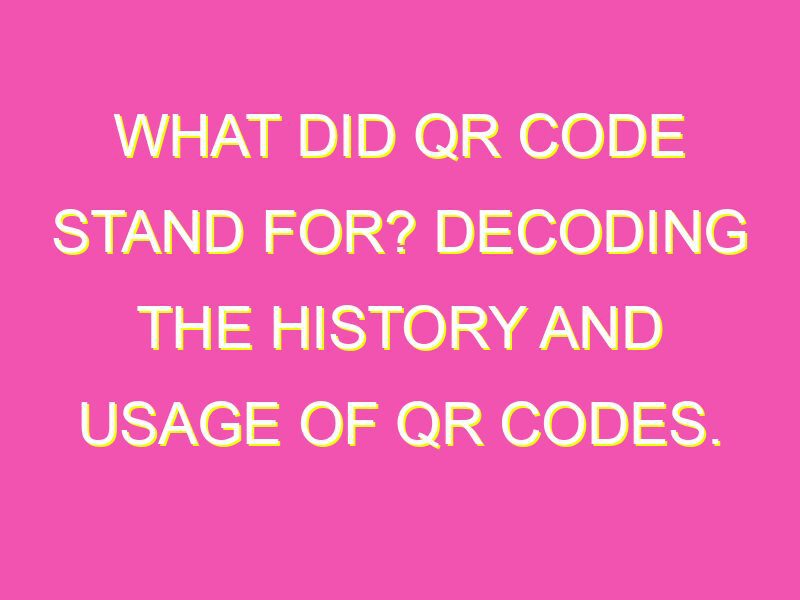Did you know that QR codes aren’t just fancy barcodes? They’re an innovative technology that has revolutionized the way we store and transmit information. Here are some interesting facts:
Despite this, QR codes continue to be an exciting development in mobile technology. They’re already being used to create innovative marketing campaigns, speed up inventory processes and enhance customer experiences. As smartphone usage continues to soar, we can only expect more of these digital gems appearing in our daily lives.
Decoding the History of QR Codes
QR Code, which stands for Quick Response Code, was first introduced in 1994 by a company called Denso Wave, a subsidiary of Toyota. The code was initiated to help with manufacturing processes, as a new type of barcode that could store more data than traditional barcodes. QR codes quickly became popular in Japan and later spread across the globe, as businesses began recognizing their potential benefits. Today, QR codes can be found on everything from product packaging to event tickets, and even on marketing materials.
Understanding the Anatomy of a QR Code
A QR code is essentially a two-dimensional barcode that consists of black and white squares arranged in a specific pattern. The code’s structure consists of three distinct components – the timing pattern, the finder pattern, and the alignment pattern. The timing pattern helps the QR code reader to identify the size and shape of the code, while the finder pattern helps to locate the code when scanned. The alignment pattern is used to help decode the code accurately. Each QR code also contains an embedded message, which can be read and decoded by a QR code scanner.
How QR Codes Work: A Quick Overview
QR codes work by using a combination of matrix codes, error correction codes, and data blocks. The matrix code is the distinctive black and white square pattern that identifies a QR code. Error correction codes protect the code’s message from being corrupted by outside interference or errors. Data blocks refer to the specific data that the QR code contains, such as a URL or text message. When a QR code is scanned, the code is read by a QR code scanner that decodes the message and displays it to the user.
Benefits of Using QR Codes in Marketing and Advertising
QR codes offer numerous benefits when used in marketing and advertising campaigns. Some of these benefits include:
- Improved customer engagement and interactivity
- Increased brand awareness
- Higher response rates to campaigns
- Customizable and trackable campaigns
- Cost-effective marketing tool
QR codes can be used in a variety of marketing and advertising strategies, from product labels to outdoor billboard ads. By incorporating QR codes, businesses can easily direct consumers to relevant information, promotions, and offers.
QR Codes vs. Barcodes: What Sets Them Apart?
While QR codes and barcodes may appear similar, there are several differences between the two. QR codes can store much more data than traditional barcodes, making them ideal for use in industries such as advertising and marketing. Barcodes typically store limited data that is restricted to numbers and basic text, while QR codes can store everything from images to website URLs.
QR Codes in the Digital Age: Trends and Innovations
With the growing digitization of our society, QR codes are also evolving with new innovations and trends. Some of the latest trends include social media integration, personalized QR codes, and the use of QR codes in augmented reality experiences. Companies are also incorporating dynamic QR codes that can be changed and updated in real-time, allowing for more dynamic and flexible marketing campaigns.
Best Practices for Creating Effective QR Codes
To create effective QR codes, businesses should follow best practices such as:
- Optimizing the size of the code for readability
- Using high contrast colors for the code’s color scheme
- Adding a clear call-to-action to encourage users to scan the code
- Testing the code before use to ensure it works on various devices and platforms
Following these best practices can help to ensure that a QR code is effective and achieves its intended outcome.
The Future of QR Codes: Where Are They Headed?
As technology continues to evolve, so too will the use and application of QR codes. Some of the latest innovations in QR code technology include the use of QR codes for ticketing, secure payments, and even health tracking. Companies are also constantly exploring new ways to incorporate QR codes into modern marketing campaigns to improve customer engagement and interaction. While QR codes may not be the “newest” technology, they continue to evolve and adapt, demonstrating their enduring relevance and value in the digital age.





